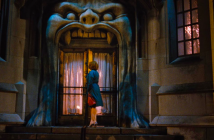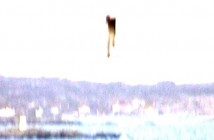Interstellar (2014)
Cast: Matthew McConaughey, Anne Hathaway, Jessica Chastain
Director: Christopher Nolan
Country: USA | UK
Genre: Adventure | Sci-Fi
Official Site: Here
Editor’s Note: Interstellar opens in theaters everywhere November 7th.
Few filmmakers can command $150 million budgets with minimal studio interference. Even fewer filmmakers can command $150 million budgets and make films not based on preexisting properties or adaptations. After co-writing and directing the Dark Knight trilogy and Inception, a non-franchise commercial and critical success, Christopher Nolan (The Prestige, Insomnia, Memento, Following) was (and is) in the second, select group. Nolan used that relative freedom to co-write and direct Interstellar, an ambitious, bold, provocative science-fiction film with the scale and scope typical of the acknowledged classics of the science-fiction genre and the intimacy and immediacy of a family/relationship drama. That Nolan’s ambition occasionally exceeds his grasp isn’t a surprise – not when we consider his uneven track record as a filmmaker – but the opposite is true as well – sometimes that ambition and the execution of that ambition perfectly align.
That Nolan’s ambition occasionally exceeds his grasp isn’t a surprise – not when we consider his uneven track record as a filmmaker – but the opposite is true as well – sometimes that ambition and the execution of that ambition perfectly align.
Set in a near future that’s also in part the near past, Interstellar centers on the singularly named Cooper (Matthew McConaughey), a one-time NASA pilot-turned-heartland farmer. A blight (or more accurately, a Blight) has destroyed most of the world’s crops, leaving only corn as the last viable crop. War, famine, and disease inevitably followed the blight, but Interstellar barely touches on the catastrophic events that surely followed a dwindling food supply, focusing instead on Cooper, Tom (Timothée Chalamet), his 15-year-old son, Murph (Mackenzie Foy), his 10-year-old daughter, and Donald (John Lithgow), his father-in-law, as they attempt to eke out a living in a near future obviously inspired by the Dust Bowl America suffered during the Great Depression. While Tom’s ambitions don’t extend beyond the family farm, Murph shares her father’s obsession with science and outer space. With NASA seemingly gone, however, Cooper and his daughter seem destined to live the remainder of their lives on Earth.
 Odd events around and inside their farmhouse suggest an anomaly of some sort. Murph thinks it’s a ghost, but the ever rational Cooper attempts to find a science-based explanation. Markings found after a dust storm, however, lead Cooper and Murph to a super-secret, underground research facility where they encounter one of Cooper’s old NASA colleagues, Professor Brand (Michael Caine, in Master of Exposition mode). There, they get the rundown on a space program tasked with finding a new home for humanity on the other side of a wormhole that mysteriously appeared four decades earlier near Saturn. With Cooper the best pilot available – the “best of the best” (sans irony) – Cooper faces a life-altering decision: stay and continue to eke out a living with his family, knowing full well that humanity won’t last past his children’s generation, or pilot the space ship, the Endurance, into the wormhole and risk never seeing his family again.
Odd events around and inside their farmhouse suggest an anomaly of some sort. Murph thinks it’s a ghost, but the ever rational Cooper attempts to find a science-based explanation. Markings found after a dust storm, however, lead Cooper and Murph to a super-secret, underground research facility where they encounter one of Cooper’s old NASA colleagues, Professor Brand (Michael Caine, in Master of Exposition mode). There, they get the rundown on a space program tasked with finding a new home for humanity on the other side of a wormhole that mysteriously appeared four decades earlier near Saturn. With Cooper the best pilot available – the “best of the best” (sans irony) – Cooper faces a life-altering decision: stay and continue to eke out a living with his family, knowing full well that humanity won’t last past his children’s generation, or pilot the space ship, the Endurance, into the wormhole and risk never seeing his family again.
It’s that decision, motivated both by selfishness (space travel, the adventure of a lifetime) and self-sacrifice (finding a new home for humanity), and not the adventure to and through the wormhole to find a habitable planet out of three possibilities, that elevates Interstellar beyond mere wonder-and-awe spectacle – though there, as elsewhere, Nolan doesn’t disappoint – into recognizably human drama. Often criticized, sometimes justly, for valuing intellect over emotion, Nolan essentially flips the script, placing emotion – and more specifically human connection – above intellect. Fans of Nolan’s intellectual puzzle game approach to narrative will be disappointed too. Interstellar deliberately leaves few questions unanswered. Nolan wouldn’t be Nolan, of course, without long, exposition-filled dialogue scenes explaining and sometimes re-explaining the hard science behind the science-fiction in Interstellar. Nolan tapped Kip Thorne, a respected theoretical physicist, to help get the science right and sufficiently simplified for general moviegoers to understand. Even then, some of the science-based conversations will strain the comprehension level of some moviegoers, but that’s more on them than Nolan. What’s different this time out, however, are the non-science based conversations, conversations that turn not on rationality, but on love; not on the love of the romantic variety, but on the love between parents and their children.
The cost of what Cooper has lost to the inexorable, inevitable passage of time, a key theme in Richard Linklater’s not dissimilar Boyhood released earlier this year, gives Interstellar a level of emotional engagement often missing from Nolan’s work.
One particularly devastating scene occurs mid-film. It’s not set on one of the planets Cooper and his crew, Amelia Brand (Anne Hathaway), Doyle (Wes Bentley), and Romilly (David Gyasi), visit on the other side of the space-bending wormhole, but on a series of video recordings from Tom and Murph, now adults, now played by Casey Affleck and Jessica Chastain, as Cooper breaks down emotionally. Time spent on the other side of the wormhole, specifically a planet near a time-distorting black hole, has left Cooper and the others only hours older, but his son and daughter 23 years older. The cost of what Cooper has lost to the inexorable, inevitable passage of time, a key theme in Richard Linklater’s not dissimilar Boyhood released earlier this year, gives Interstellar a level of emotional engagement often missing from Nolan’s work. To some, that scene, as well as Nolan’s continued insistence on the unbreakable bond between Cooper and Murph will seem like cheap sentiment. As long as it’s earned, sentiment isn’t objectionable per se. It has to be earned, something Interstellar unquestionably achieves.
Interstellar is far from flawless, however. At times, Nolan’s influences (e.g., 2001: A Space Odyssey, Close Encounters of the Third Kind, Contact, among others) slip into the foreground, at times making Interstellar feel like a “greatest hits” compilation of superior science-fiction films. A middle-section involving an entirely new character, a stranded astronaut, doesn’t entirely work. Like Doyle and Romilly, the third character never develops or evolves beyond functioning as a delivery device for Nolan’s pet ideas (in this case, evolutionary biology’s take on the survival instinct). The astronaut’s odd syntax and speech patterns might be the result of bad writing (probable) or an attempt to illustrate the character’s deteriorating mental state (possible, if not probable). While distinctive, Hans Zimmer’s organ-based score drowns out key dialogue on several occasions. Even with those drawbacks, however, Interstellar’s mix of awe-and-wonder-driven spectacle – much of it practical, not CG – and resonant, character drama are unlikely to be matched this fall (or any other fall).
Interstellar’s mix of awe-and-wonder-driven spectacle – much of it practical, not CG – and resonant, character drama are unlikely to be matched this fall (or any other fall).



